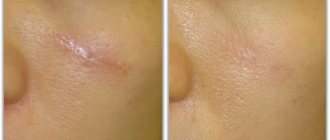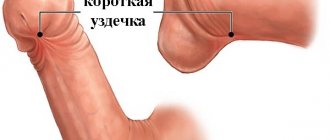Male circumcision (circumcision) is a minimally invasive surgical procedure to remove the foreskin of the penis, leaving the glans either partially covered by skin or completely exposed.
Such surgery is performed for several reasons:
- for medical reasons for a number of pathological conditions that require mandatory removal of the foreskin (phimosis, congenital anomalies of the penis, precancerous conditions);
- to prevent premature ejaculation and prolong sexual intercourse (in some cases, after removing the foreskin, the head of the penis becomes less sensitive, which allows sexual intercourse to last longer);
- based on religious considerations (Jews and Muslims) or to indicate nationality;
- for hygienic purposes.
You can find out how much it costs to circumcise the foreskin of an adult man in Moscow below. Specialists from the Federal Scientific and Clinical Center of the Federal Medical and Biological Agency of Russia guarantee a painless procedure and obtain the desired result through the use of the latest technologies and modern surgical practices.
In what cases is circumcision necessary?
Among the main medical indications for circumcision of the foreskin, experts identify:
- phimosis, which is accompanied by the inability to expose the head due to thickening or narrowing of the foreskin (the ailment can be a congenital defect or acquired);
- paraphimosis or pinching of the glans penis by a pathologically narrowed foreskin;
- recurrent inflammation of the head and foreskin (balanoposthitis), associated with poor genital hygiene, infection of soft tissues, etc.;
- multiple condylomatous growths around the head;
- precancerous conditions of the mucous membranes with a high risk of oncological transformation.
Circumcision in Moscow can be performed not only for medical reasons. The reason for its implementation may be hygienic and aesthetic purposes. The fact is that the foreskin is a place where infectious agents, moisture, dead cells and sebaceous gland secretions accumulate. It is these conditions that provide an ideal environment for the development of an inflammatory process that can disrupt sexual and urinary function. Male circumcision is one of the effective ways to prevent sexually transmitted infections.
Indications for use
Medical reasons for circumcision include:
- Phimosis. The pathology is manifested by painful opening of the skin folds of the penis. In the later stages of the disease, it is not possible to open the head.
- Short bridle.
- Balanitis, balanoposthitis, which have passed into the chronic stage. A favorable environment for the development of bacteria is created under the prepuce.
- Premature ejaculation. After circumcision, the head becomes coarser and the sensitivity of the endings decreases.
- Circumcision of the foreskin reduces the risk of contracting human papillomavirus, herpes, and HIV.
The main non-medical reason is religious views. Circumcision is practiced among Muslims and Jews.
Phimosis causes a lot of troubles - from poor hygiene to problems in sexual life. Untreated phimosis can lead to pinching of the head (paraphimosis).
Temporary contraindications include: urinary tract infections, pustular lesions, structural changes in the penis (plasty may be required).
Circumcision of the foreskin for phimosis
Most often, excision of the foreskin in representatives of the stronger sex is carried out specifically for phimosis. This diagnosis refers to a narrowing of the foreskin, in which the head of the penis is difficult to expose during erection. Surgical intervention eliminates the pinching ring of the foreskin that forms during phimosis.
The operation to remove phimosis in men is carried out in our medical center, the price of the procedure is as affordable as possible for a wide range of patients and fully corresponds to the declared result. You can find out the cost of treatment and surgery for phimosis, ask questions and set a date for surgery in consultation with a specialist.
Price and cost of phimosis surgery in children:
| Service | Price |
| Phimosis: Circumcision of the foreskin | 20000 |
| Phimosis (circumcision) with frenuloplasty | 35000 |
| Phimosis (circumcision) with meatal stenosis (urethral stenting) | 49000 |
| Phimosis (circumcision) with meatal stenosis (urethral stenting) and frenuloplasty | 65000 |
| Treatment of meatal stenosis (1st degree of complexity) | 39000 |
| Treatment of meatal stenosis (difficulty level 2) | 49000 |
| Treatment of meatal stenosis (grade 3) | 58000 |
The price list published on the website is not a public offer agreement. The provision of services is carried out on the basis of an agreement for the provision of medical services. You can find out the cost of the service during the consultation.
*The cost of the operation includes:
- inpatient placement 1 day
- all disposable surgical consumables and instruments
- application of an intradermal cosmetic suture - no need to remove the sutures!
- constant telephone communication with the attending physician
- examination any day in the clinic within 30 days after surgery
- all dressings included
The cost of the operation does not include:
- anesthesia care
- preoperative tests
Don't waste your precious time - call!
Our specialists will be happy to answer all your questions
+7
Our advantages
Experienced surgeons
Individual approach
Without pain and fear
Comfortable conditions
Types of circumcision
Already at the first visit to the surgeon, the patient has the opportunity to learn about the options for performing surgery to remove the foreskin. There are several types of surgery currently being performed:
- low circumcision, when the inner edge of the tissue is completely excised with a suture placed along the edge of the coronary groove;
- medium circumcision, after which part of the foreskin is preserved, and the seam is located 1.5 cm above the base of the penis;
- a high type of circumcision, in which the surgeon leaves the inner layer of the foreskin and makes a suture no closer than 2 cm from the base of the penis.
Minimum operation type
In this type of circumcision, a small portion of the foreskin is removed. Such an operation is performed primarily on those patients who resort to the procedure for religious reasons, but do not want to make significant changes to the physiology and appearance of the genital organ.
Partial excision
As a result of such surgical correction, the head of the penis remains fragmentarily covered with soft tissue, and the urethral opening is free.
Non-tight excision
In this case, the foreskin is removed in large quantities, while the coronary groove remains covered with a fold of skin.
Moderate type
The surgeon cuts the skin and completely exposes the head of the penis, which does not hide even when exposed to low temperatures. The appearance of the penis changes significantly.
Tight excision
The foreskin is completely removed, after which the skin becomes very stretched during an erection. Tight circumcision is done very rarely. It is prescribed for strict medical reasons or at the request of the patient himself.
Surgical methods
Circumcision refers to plastic surgery. Modern surgery offers several intervention options; the choice depends on the joint decision of the patient and the doctor.
- Partial. Often used for phimosis and paraphimosis. Only part of the foreskin is removed, allowing the glans to be exposed. At rest, it is half hidden by a fold of skin.
- Free. Fully opens the head of the penis. A groove is formed in the coronal region of the genitals.
- Minimal. This circumcision process is used for cicatricial phimosis or excessive growth of the foreskin. Only excess hanging skin is removed; at rest, the head is completely closed.
- Tight. The entire foreskin is cut off, the head is completely open. This circumcision procedure is carried out only after detailed consultations with a urologist; contraindications are possible.
- High. It is used for significant growth of the foreskin. The circular postoperative suture can be located at different heights.
- Low. The incision to remove the skin fold is made in the coronary groove, which also hides the postoperative suture.
Circumcision surgery is irreversible, so before starting it it is necessary to weigh all the advantages and disadvantages. Complications are rare; in some cases, allergies to medications or scarring are possible.
How is foreskin circumcision performed?
Circumcision is a minimally invasive surgical procedure that does not require a long hospital stay or hospitalization. It is performed under local anesthesia, but sometimes the doctor may decide whether to use general anesthesia.
During surgical circumcision, a circular excision of the foreskin is performed, after which the wound is sutured with threads that dissolve on their own. The volume of tissue removal and the location of the sutures are discussed with the patient before the procedure.
Why do we recommend circumcision surgery with us?
The main reasons why an adult man should have surgery to circumcise the foreskin at the Federal Scientific and Clinical Center of the Federal Medical and Biological Agency:
- competence and high qualifications of medical staff necessary to carry out high-quality surgical intervention without consequences;
- the most reasonable price;
- complete confidentiality of patient information;
- predictability of results, when a man can count on exactly the effect that was agreed upon with the surgeon before the procedure;
- the use of modern painkillers, which makes the procedure easy and painless.
What should you know about the circumcision procedure?
Circumcision in boys and men is a relatively simple procedure performed by a urologist, andrologist or plastic surgeon. Anesthesia is predominantly local, treatment is a day hospital stay. To remove the prepuce, use a scalpel (classical method) or laser. The edges of the residual skin are sutured with absorbable sutures. Circumcision is performed for phimosis, paraphimosis, lichen sclerosus, and cancer. Mild discomfort or swelling is possible for 3-4 days, which quickly passes.
Preparation for circumcision
After the patient has paid the cost of male circumcision surgery in Moscow, he needs to undergo special preparation for surgery, including:
- make an appointment with a doctor who must examine the patient, decide on the type of circumcision and the extent of the operation;
- stop drinking alcoholic beverages and smoking several days before the procedure;
- pass mandatory tests (general and biochemical blood and urine tests, urethral culture for microflora, other tests prescribed by a specialist);
- adhere to the rules of genital hygiene;
- stop taking blood thinning medications for a while.
In the vast majority of clinical cases, the operation to circumcise the foreskin is performed under local anesthesia; immediately before the procedure, the man is allowed a light breakfast. If the surgeon decides to use general anesthesia, the patient is prohibited from eating from the second half of the day preceding the date of surgery.
Myths and facts about circumcision
Here are some of them:
- Female circumcision - the term circumcision does not only refer to the male part of the population. It is frowned upon in modern society and is prohibited by law in most countries. But female circumcision does exist and involves the removal of the external parts of the female genitalia. It has no health benefits, but on the contrary, most often causes complications.
- Hygiene - with proper care there is no difference in the hygiene of circumcised and uncircumcised persons.
- Sexual intercourse – you should not have sexual intercourse unless you are recovering from circumcision. Some even consider circumcision an advantage because relationships can last longer - circumcised men have a higher degree of sensitivity. But from a woman's point of view, nothing changes.
Rehabilitation after circumcision
The man is allowed to leave the clinic 2 hours after the procedure to remove the foreskin. When excision of soft tissues in the classical way, for several days after surgery, the patient may experience the following complaints:
- development of swelling with redness at the surgical site;
- the appearance of nagging pain in the area of the postoperative wound;
- discomfort during urination and when the genital organ comes into contact with underwear.
All these unpleasant consequences go away on their own after a few days. Most often, they are mild, so most patients continue to do their usual activities the next day.
Dehiscence of the sutures placed by the surgeon is the most common complication. Moreover, in most clinical cases it occurs due to the fault of the patient himself. To ensure that the rehabilitation period passes as quickly and efficiently as possible, experts advise following several recommendations:
- in order to prevent the development of the inflammatory process, doctors prescribe patients a preventive course of antibiotic therapy and drugs with anti-inflammatory effects, and in case of persistent pain, prescribe analgesics;
- It is prohibited to visit the pool, take hot baths, play sports, lift weights, or take a steam bath or sauna for several weeks;
- You must avoid sexual intercourse for 2 weeks.








